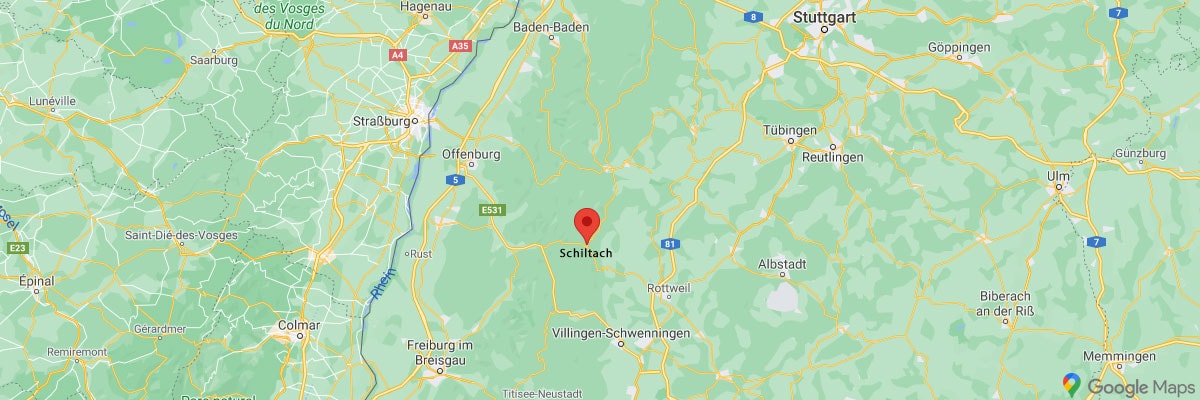The half-timbered town of Schiltach is part of the German Half-Timbered Road and is considered one of the most famous and beautiful excursion destinations in the Black Forest. The historic town in the valley of the Kinzig river is characterized by a medieval townscape, artfully renovated half-timbered houses and a town hall from the 16th century.

Table of contents
Things to know about the half-timbered town of Schiltach
The state-approved climatic health resort Schiltach is located in the Middle Black Forest and has about 4,000 inhabitants. The small half-timbered town was first mentioned as a parish in 1275, when the dukes of Teck founded the town and schiltach castle to secure their territories. In the 16th century, Schiltach was destroyed by three major city fires, but then rebuilt by a well-known city architect.
In earlier centuries, the city was important for rafting and tanning also has a great tradition in the city. Therefore, Schiltach is also referred to as “the city of half-timbering, raftsmen and tanners“. Today there are 4 museums in the city that invite you to visit. In addition, the Trauwein tannery is one of the last tanneries that cultivates the traditional art of tanning in a “chametic” way with a lot of manual work and expertise.
The eponymous river Schiltach
From the city bridge you have a very nice view of the river Schiltach to which the city owes its name. “Schiltach” is composed of the words “Schilt” (shield-shaped slope in the river triangle) and “ach” (old german word for water). It is also worth a short walk on the Bachstraße, which runs right next to the Schiltach, as from here you have a beautiful view of the opposite side of the city.
The Market Square & the Town Hall
Since 1971, the Old Town with its half-timbered houses from the 16th to the 19th century has been a listed building. The heart of the “Städtle” – as the city is called by locals – is the beautiful Schiltacher Marktplatz with its town hall in Renaissance style, the closed half-timbered ensemble and the city fountain. The town hall is the landmark of the city and has stood at the highest point of the market square since 1593. We particularly liked the façade painting on the striking front gable of the town hall, which, however, was only created in 1942.
Worth mentioning is the Pharmacy Museum on the market square, because it is the largest private museum about the history of pharmacists in Germany. Until 1985, the building housed the former Rats-Apotheke, founded in 1837. After its closure, it was reopened in 1989 as a museum while retaining its traditional Biedermeier root wood furnishings. Unfortunately, the museum was closed, otherwise we would certainly have taken a look inside. We have already been to Heidelberg Castle before in a pharmacy museum and we liked that very much.
The Schiltacher Stadtmuseum
Another museum on the market is the Schiltacher Stadtmuseum which is located on the left directly at the entrance to the market square and is accessible free of charge. During a tour through the eleven rooms of the building, we were able to get a good insight into the history of the half-timbered town.
The “Hintere Städtle”
If you leave the city fountain on the market square on the right, you reach the Schenkenzeller Straße, where today multi-storey, high-gabled half-timbered houses from the 16. and 17th century. This part of the half-timbered town is also referred to as the “Hinteres Städtle”. Once the main street ran along here, today the street is a very picturesque and traffic-calmed residential area.
More impressions of the historic old town
During our tour through the half-timbered town, we passed many other houses worth seeing. We particularly noticed the Outer Mill which is Schiltach’s oldest house from 1557, where the citizens used to grind their grain. The Protestant town church is a sandstone building from the years 1839 to 1843. It looks very simple from the outside, but is still one of the largest and most magnificent Protestant churches in Baden today. One of the most beautiful half-timbered houses is certainly the white-red Gasthaus Adler which impresses with a very beautiful bay tower and pretty green shutters.
The Schlossberg
If you have enough breath, you can make a detour from the market square up to the 417-meter-high Schlossberg, on which Schiltach Castle was built in the 13th century. Since it was demolished from 1825 because of its dilapidated substance, unfortunately nothing can be seen of it today. For the beautiful view, however, the ascent is always worthwhile.

